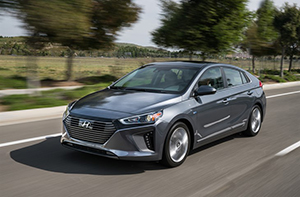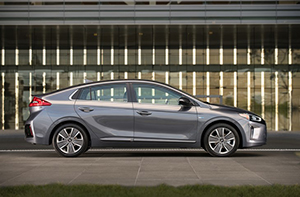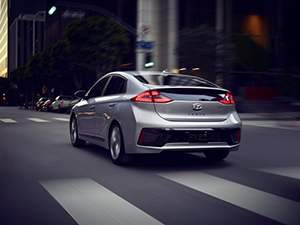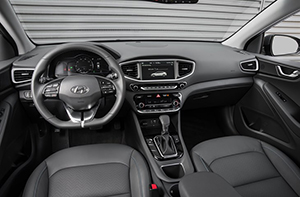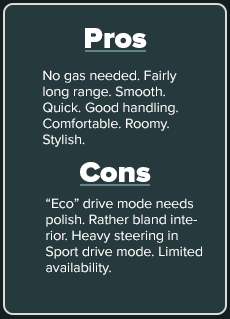2017 Hyundai Ioniq
Electric
The 2017 Hyundai Ioniq
Electric comes as a smooth all-electric four-door hatchback with a
136-mile driving rating.
Price: $35,000 estimated
The new Hyundai Ioniq electric four-door hatchback sedan
isn’t for a quick run from Chicago to Las Vegas but promises
to be a good vehicle for normally short distances.
Want to give it a try? Well, patience, because it’s not yet
in dealerships as of this writing in early spring. And it initially
will be offered only in California.
Note that there also are are two other Ioniq models: a regular
gas-electric hybrid and a plug-in gas-electric hybrid with a regular
grille. Ioniqs will have estimated an price range of $25,000-$35,000.
Aimed at the Toyota Prius, I’m guessing that the Ioniq
Electric, which I tested, will list at approximately $30,000-$35,000.
It’s the most interesting of the Ioniq line.
Of course, Ioniq owners should have an outlet to eventually charge up
the car.
Hyundai is working with an outfit called Chargepoint to
“further enhance the Ioniq Electric ownership
experience.” ChargePoint is said to have the
world’s largest electric vehicle charging network with more
than 32,000 locations at which to charge, including more than 400
Express DC fast-charging sites.
Indeed, the Ioniq has fast-charging capability. Charging its
lithium-ion polymer battery up to 80 percent only takes approximately
23 minutes using a fast charger. Drivers can also charge the Ioniq with
a standard household electric socket.
The Ioniq electric motor has a maximum output of 118 horsepower but 218
pound/feet of torque mated to a single gear reduction-gear
transmission. The car provided a “whoosh” feel and
a slight boot in the back every time I accelerated. It’s
quick off the line and 65-75 m.p.hj. passing is a breeze.
The electric motor has an EPA-estimated 136 mile-per-gallon rating,
which Hyundai says is the “highest efficiency rating of any
electric vehicle sold in the U.S.
Market.”
The Ioniq has its own styling with a slick front end with no grille.
The front reminds me of the one on the still-racy-looking 1960s
Studebaker Avanti. With no Ioniq gas engine to cool, who needs a front
end with a grille? The other two gas-electric Ioniq models have a
regular grille.
Stretched across the hatch lid is the word
“Electric,” which is easily noticed. And, of
course, there are no tailpipes. The hatch has a small glass area at its
bottom and a large glass area at the top, with a thin bar separating
the two areas. Some drivers may object to seeing that bar in the
rearview mirror, but I hardly noticed it. The racy 1970s Maserati
Khamsin sports car had a similar setup.
The Ioniq has incredibly smooth operation and
“Normal” “Eco” and
“Sport “driving modes. Sport mode
tightens things up (steering, suspension etc.) for aggressive driving,
but hurts driving range a bit.
The Eco model is said to enhance range but made it feel like the brakes
were dragging a little when I took my foot off the gas pedal. Also,
Hyundai says acceleration response may be slightly reduced in that
mode, the air conditioner performance may be limited and the shift
pattern may change.
I spent most of my time in Normal mode, which was best for the
smoothest performance.
The Ioniq Electric is very aerodynamic and has all the comfort and
convenience of a nicely engineered four-passenger sedan, with flip
forward seat backs that greatly increase the decent-sized cargo area.
The steering is firm but accurate, but gets heavy in Sport drive mode.
The suspension provides a smooth ride, and the Ioniq easily sweeps
through decreasing radius freeway ramps. The brake pedal has a nice
linear feel.
The Ioniq’s nicely laid out interior looked rather drab. It
would have been livened up with, for instance, red seat and door
stitching, not the nearly invisible stitching it had.
The Ioniq is started with the push of a dashboard button, and there are
large console buttons for Drive, Reverse and Park. Gauges can be
quickly read, controls are easy to use, as is the touchscreen. Front
seats provide good overall support.
There’s good room in the quiet interior for four tall
occupants, and flip-down rear seat backs greatly increase the
decent-size cargo area.
The Ioniq apples a torsion-beam rear axle that provides more space for
its 28 batteries placed below the rear seats.
Safety items include a rearview camera, blind spot detection system,
electronic stability control and lane departure warning system,
automatic emergency braking with Pedestrian Detection.
The Hyundai Ioniq Electric promises to be a good contender in the
growing electric vehicle market.

